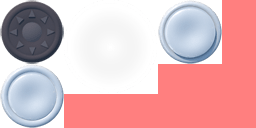Difference between revisions of "TntVirtualPad"
From GiderosMobile
| Line 73: | Line 73: | ||
<!--[[Event.ADDED_TO_STAGE]]<br/>--><!-- GIDEROSEVT:Event.ADDED_TO_STAGE addedToStage--> | <!--[[Event.ADDED_TO_STAGE]]<br/>--><!-- GIDEROSEVT:Event.ADDED_TO_STAGE addedToStage--> | ||
=== Constants === | === Constants === | ||
| − | [[PAD.BUTTONS_NONE]]<br/><!-- GIDEROSCST:PAD.BUTTONS_NONE | + | [[PAD.BUTTONS_NONE]]<br/><!-- GIDEROSCST:PAD.BUTTONS_NONE 3--> |
| − | [[PAD.BUTTONS_ONE]]<br/><!-- GIDEROSCST:PAD.BUTTONS_ONE | + | [[PAD.BUTTONS_ONE]]<br/><!-- GIDEROSCST:PAD.BUTTONS_ONE 4--> |
| − | [[PAD.BUTTONS_TWO]]<br/><!-- GIDEROSCST:PAD.BUTTONS_TWO | + | [[PAD.BUTTONS_TWO]]<br/><!-- GIDEROSCST:PAD.BUTTONS_TWO 5--> |
| − | [[PAD.BUTTONS_THREE]]<br/><!-- GIDEROSCST:PAD.BUTTONS_THREE | + | [[PAD.BUTTONS_THREE]]<br/><!-- GIDEROSCST:PAD.BUTTONS_THREE 6--> |
| − | [[PAD.BUTTONS_FOUR]]<br/><!-- GIDEROSCST:PAD.BUTTONS_FOUR | + | [[PAD.BUTTONS_FOUR]]<br/><!-- GIDEROSCST:PAD.BUTTONS_FOUR 7--> |
| − | [[PAD.BUTTONS_FIVE]]<br/><!-- GIDEROSCST:PAD.BUTTONS_FIVE | + | [[PAD.BUTTONS_FIVE]]<br/><!-- GIDEROSCST:PAD.BUTTONS_FIVE 8--> |
| − | [[PAD.BUTTONS_SIX]]<br/><!-- GIDEROSCST:PAD.BUTTONS_SIX | + | [[PAD.BUTTONS_SIX]]<br/><!-- GIDEROSCST:PAD.BUTTONS_SIX 9--> |
| − | [[PAD.STICK_NONE]]<br/><!-- GIDEROSCST:PAD.STICK_NONE | + | [[PAD.STICK_NONE]]<br/><!-- GIDEROSCST:PAD.STICK_NONE 0--> |
| − | [[PAD.STICK_SINGLE]]<br/><!-- GIDEROSCST:PAD.STICK_SINGLE | + | [[PAD.STICK_SINGLE]]<br/><!-- GIDEROSCST:PAD.STICK_SINGLE 1--> |
| − | [[PAD.STICK_DOUBLE]]<br/><!-- GIDEROSCST:PAD.STICK_DOUBLE | + | [[PAD.STICK_DOUBLE]]<br/><!-- GIDEROSCST:PAD.STICK_DOUBLE 2--> |
|} | |} | ||
{{GIDEROS IMPORTANT LINKS}} | {{GIDEROS IMPORTANT LINKS}} | ||
Revision as of 09:38, 3 December 2020
Supported platforms: ![]()
![]()
![]()
![]()
![]()
![]()
![]()
Available since: Gideros 2019.4
Description
Adds a virtual pad to your game/app screen.
You can find the graphics for the pads and the text file that comes with it:
Examples
Add a virtual pad to your scene
require "tntvirtualpad"
LevelX = Core.class(Sprite)
function LevelX:init()
-- bg
application:setBackgroundColor(0x0099a0)
-- tnt virtual pad
local texturevpad = TexturePack.new("gfx/UI/TNTVirtualPad.txt", "gfx/UI/TNTVirtualPadX.png", true)
self.vPad = CTNTVirtualPad.new(self, texturevpad, PAD.STICK_SINGLE, PAD.BUTTONS_ONE, 100, 0)
self.vPad:setJoyStyle(PAD.COMPO_LEFTPAD, PAD.STYLE_FOLLOW)
self.vPad:setScale(PAD.COMPO_LEFTPAD, 1)
self.vPad:setScale(PAD.COMPO_BUTTON1, 1)
self.vPad:setHideDelay(5000)
self.vPad:start()
-- tnt virtual pad listeners
self.vPad:addEventListener(PAD.LEFTPAD_EVENT, self.onVKeyDown, self)
self.vPad:addEventListener(PAD.BUTTON1_EVENT, self.vShoot, self)
end
-- VIRTUAL PAD HANDLER
function LevelX:onVKeyDown(event)
print(event.data.power)
print(event.data.angle)
print(math.cos(event.data.angle))
print(math.sin(event.data.angle))
-- example usage
--self.player.posx += self.player.vx * math.cos(event.data.angle)
--self.player.posy += self.player.vy * math.sin(event.data.angle)
--if math.cos(event.data.angle) < 0 then self.player:setSkew(5, -5)
--elseif math.cos(event.data.angle) > 0 then self.player:setSkew(-5, 5)
--else self.player:setSkew(0, 0)
--end
end
function LevelX:vShoot(event)
if event.data.state == PAD.STATE_BEGIN then
-- example usage
--local missile = Missiles.new(self.player.posx, self.player.posy - 12)
--table.insert(self.missiles_list, missile)
end
end
MethodsCTNTVirtualPad.new creates a new VPAD object class CTNTVirtualPad:free frees the VPAD |
EventsConstantsPAD.BUTTONS_NONE |
